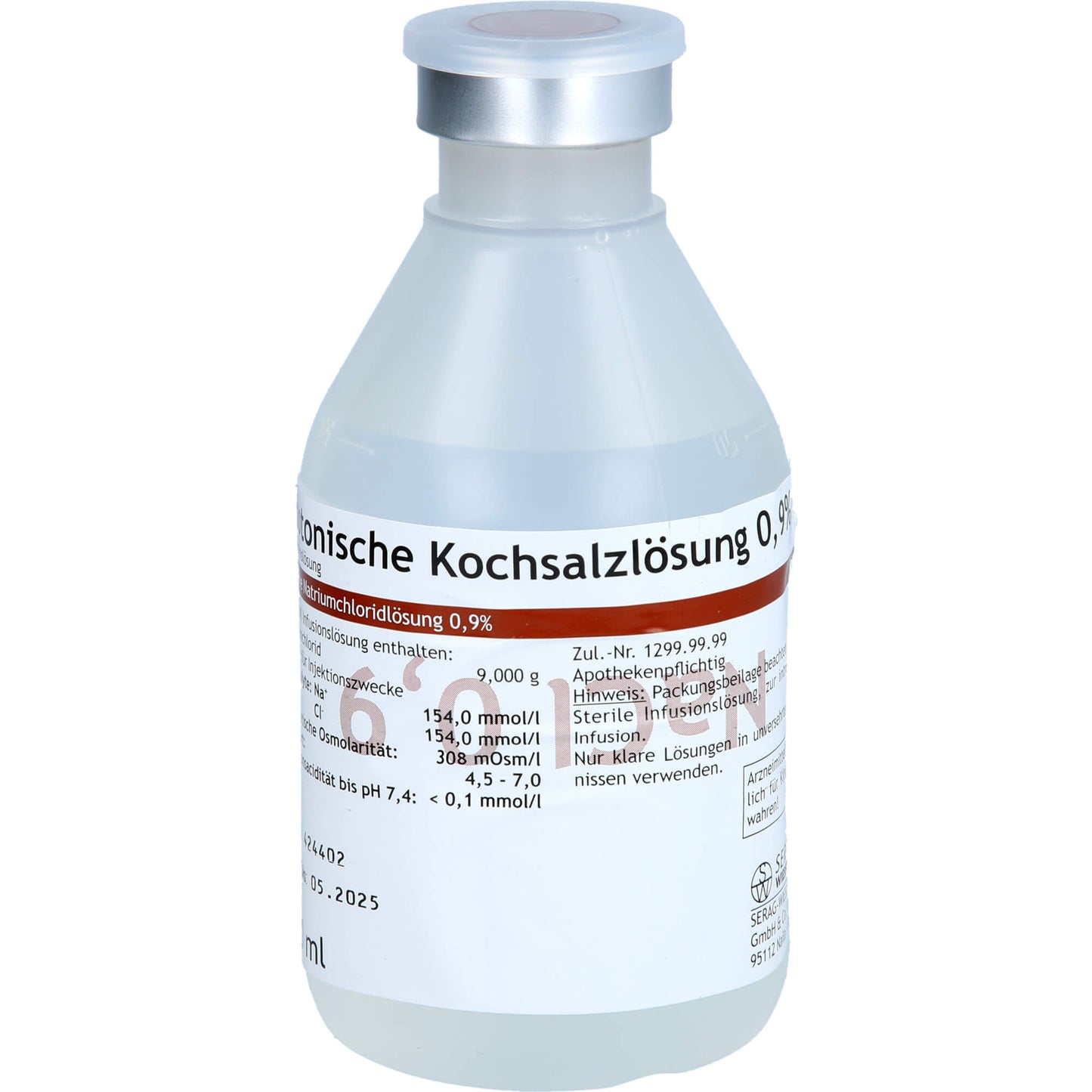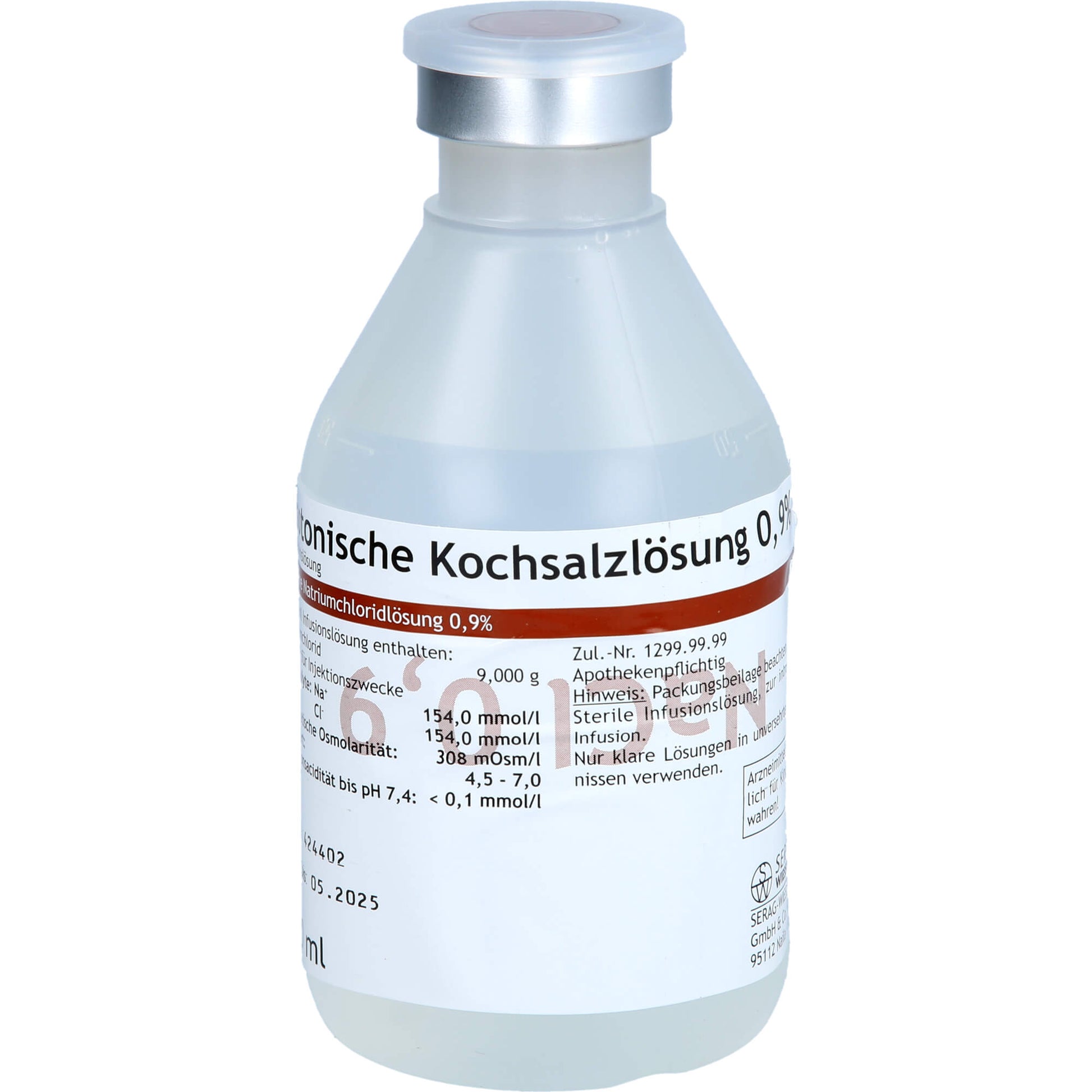SERAG-WIESSNER GmbH & Co.KG
Hypochloremic metabolic alkalosis, ISOTONIC saline solution 0.9% plastic inf. solution
Hypochloremic metabolic alkalosis, ISOTONIC saline solution 0.9% plastic inf. solution
Couldn't load pickup availability
ISOTONIC saline solution 0.9% plastic inf. solution, Hypochloremic metabolic alkalosis
Isotonic saline solution 0.9% infusion solution. Indications: Fluid and electrolyte replacement in cases of hypochloremic alkalosis, chloride loss, short-term intravascular volume replacement, hypotonic dehydration, isotonic dehydration.
For risks and side effects, read the package insert and ask your doctor or pharmacist.
PACKAGE LEAFLET: INFORMATION FOR THE USER
Isotonic saline solution 0.9% infusion solution
. This package insert contains:
- WHAT IS ISOTONIC SALINE 0.9% AND WHAT IS IT USED FOR?
- WHAT SHOULD YOU CONSIDER BEFORE USING ISOTONIC SALINE SOLUTION 0.9%?
- HOW SHOULD ISOTONIC SALINE SOLUTION 0.9% BE USE?
- WHAT SIDE EFFECTS ARE POSSIBLE?
- HOW SHOULD ISOTONIC SALINE SOLUTION 0.9% BE STORED?
- MORE INFORMATION
1. WHAT IS ISOTONIC SALINE SOLUTION 0.9% AND WHAT IS IT USED FOR?
Substance or indication group:
Electrolyte solution. Na+: 0.154 mmol/ml or 154 mmol/l, Cl-: 0.154 mmol/ml or 154 mmol/l
. Areas of application:
- Fluid and electrolyte replacement in hypochloremic alkalosis,
- Chloride losses,
- short-term intravascular volume replacement,
- hypotonic dehydration,
- isotonic dehydration.
2. WHAT SHOULD YOU CONSIDER BEFORE USING ISOTONIC SALINE SOLUTION 0.9%?
Contraindications:
Absolute contraindication:
- Overhydration conditions (hyperhydration conditions).
Relative contraindications:
- reduced potassium content in the blood (hypokalemia).
- increased sodium content in the blood (hypernatremia).
- increased chloride content of the blood (hyperchloremia).
- Diseases requiring restrictive sodium intake (e.g. heart failure, generalized edema, pulmonary edema, hypertension, eclampsia, severe renal insufficiency).
Precautions for use and warnings:
Monitoring of electrolyte and fluid status is required.
Interactions with other medicinal products:
None known to date. For information on incompatibility, see ###Additional information for healthcare professionals###.
Pregnancy and breastfeeding:
There are no concerns about use during pregnancy and breastfeeding.
3. HOW SHOULD ISOTONIC SALINE SOLUTION 0.9% BE USED?
Dosage instructions:
The dosage is generally based on fluid and electrolyte requirements (40 ml/kg body weight/day or 2 mmol sodium/kg body weight/day). The following guidelines apply:
Maximum infusion rate:
Depends on the clinical situation.
Maximum daily dose:
The maximum daily dose is determined by fluid and electrolyte requirements. For adults, a value of 3 - 6 mmol sodium/kg body weight applies, for children 3 - 5 mmol sodium/kg body weight. In cases of hypertonic dehydration, excessively rapid infusion rates must be avoided (caution: increase in plasma osmolarity and plasma sodium concentration).
Method of administration:
For intravenous infusion.
Overdose:
Symptoms of overdose include:
- Overwatering.
- increased sodium and chloride levels in the blood (hypernatremia, hyperchloremia).
- Hyperosmolarity.
- Induction of an acidotic metabolic state.
Therapy:
Interruption of the solution supply, accelerated elimination via the kidneys, and reduced supply of the corresponding electrolytes.
If you have any questions on the use of this medicine, consult your doctor or pharmacist.
4. POSSIBLE SIDE EFFECTS:
Increased sodium and chloride levels in the blood (hypernatremia, hyperchloremia).
Reporting of side effects:
If you notice any side effects, contact your doctor or pharmacist. This also applies to side effects not listed in this package leaflet. You can also report side effects directly to the Federal Institute for Drugs and Medical Devices, Pharmacovigilance Department, Kurt-Georg-Kiesinger-Allee 3, D-53175 Bonn, website: www.bfarm.de. By reporting side effects, you can help provide more information on the safety of this medicine.
Additional information for healthcare professionals:
Reporting of suspected side effects:
Reporting suspected side effects after authorization is very important. It enables continuous monitoring of the benefit-risk ratio of the medicinal product. Healthcare professionals are asked to report any suspected adverse reactions to the Federal Institute for Drugs and Medical Devices, Pharmacovigilance Department, Kurt-Georg-Kiesinger Allee 3, D-53175 Bonn
5. HOW SHOULD ISOTONIC SALINE SOLUTION 0.9% BE STORED?
Do not use after the expiry date printed on the container and outer packaging! Keep out of the sight and reach of children! Use immediately after opening the container! Use only clear solutions in undamaged containers! Never dispose of medicines via wastewater (e.g., not down the toilet or sink). Ask your pharmacist how to dispose of medicines no longer required. This will help protect the environment. Further information can be found at www.bfarm.de/arzneimittelentsorgung.
6. FURTHER INFORMATION
Composition:
1000 ml of infusion solution contains: Active ingredient: Sodium chloride 9.000 g. Other ingredients: Water for injections. Theoretical osmolarity: 308 mOsm/l. pH: 4.5 - 7.0.
Dosage
form: Infusion solution. Glass or plastic bottle. Contents: 100 ml, 250 ml, 500 ml and 1000 ml.
Pharmaceutical Entrepreneur/Manufacturer:
Serag-Wiessner GmbH & Co. KG
Zum Kugelfang 8 - 12
95119 Naila, Germany
This leaflet was last revised in October 2024.
Source: Information from the package leaflet.
Status: 08/2025
Indications: Fluid and electrolyte substitution in hypochloremic alkalosis, chloride losses, short-term intravascular volume replacement, hypotonic dehydration, isotonic dehydration.
Hypochloremic metabolic alkalosis, ISOTONIC saline solution 0.9% plastic inf. solution
Share



